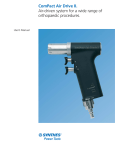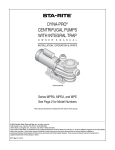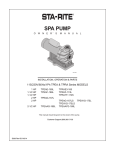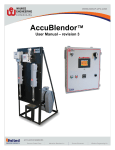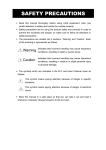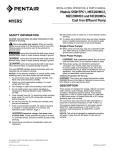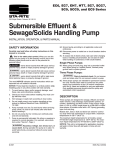Download Centrifugal Pumps
Transcript
Series For "C" Series Sleeved Impellers with positive locking screw ! " ! # ! " " " $ PLEASE READ THE FOLLOWING INFORMATION PRIOR TO INSTALLING AND USING Webster PUMPS or HAYWARD VALVES, STRAINERS, FILTERS, AND OTHER ASSOCIATED PRODUCTS. FAILURE TO FOLLOW THESE INSTRUCTIONS MAY RESULT IN SERIOUS INJURY. 1. 2. 3. 4. 5. 6. 7. 8. Webster and Hayward guarantees their products against defective material and workmanship only. Webster and Hayward assume no responsibility for damage or injuries resulting from improper installation, misapplication, or abuse of any product. Webster and Hayward assume no responsibility for damage or injury resulting from chemical incompatibility between their products and the process fluids to which they are subjected. Compatibility charts provided in Webster and Hayward literature are based on ambient temperatures of 70 ºF and are for reference only. Customer should always test to determine application suitability. Consult Webster and Hayward literature to determine operating pressure and temperature limitations before installing any Webster and/or Hayward product. Note that the maximum recommended fluid velocity through any Webster and Hayward product is eight feet per second. Higher flow rates can result in possible damage due to the water hammer effect. Also note that maximum operating pressure is dependent upon material selection as well as operating temperature. Webster and Hayward products are designed primarily for use with non-compressible liquids. They should NEVER be used or tested with compressible fluids such as compressed air or nitrogen. Systems should always be depressurized and drained prior to installing or maintaining Webster and Hayward products. Temperature effect on piping systems should always be considered when the systems are initially designed. Piping systems must be designed and supported to prevent excess mechanical loading on Webster and Hayward equipment due to system misalignment, weight, shock, vibration, and the effects of thermal expansion and contraction. Because PPL, PVC and CPVC plastic products become brittle below 40 ºF, Webster and Hayward recommends caution in their installation and use below this temperature. Published operating torque requirements are based upon testing of new valves using clean water at 70 ºF. Valve torque is affected by many factors including fluid chemistry, viscosity, flow rate, and temperature. These should be considered when sizing electric or pneumatic actuators. Due to differential thermal expansion rates between metal and plastic, transmittal of pipe vibration, and pipe loading forces DIRECT INSTALLATION OF METAL PIPE INTO PLASTIC CONNECTIONS IS NOT RECOMMENDED. Wherever installation of plastic valves into metal piping systems is necessary, it is recommended that at least 10 pipe diameter in length of plastic pipe be installed upstream and downstream of the plastic valve to compensate for the factors mentioned above. This manual should be furnished to the end user of this pump; its use will reduce service calls and chance of injury and will lengthen pump life. One Hayward Industrial Drive Clemmons, NC 27012-5100 Tel: 1-888-429-4635 Fax: 1-888-778-8410 WEB: www.haywardindustrial.com S5000 April 05 Email: [email protected] Page 1 of 6 Series I. SEAL CHANGING INSTRUCTIONS NOTICE: Before working on pump, do the following: Wear protective clothing (gloves, safety glasses, etc.) to prevent strong chemicals from burning skin. Flush pump to neutralize any chemical residue. Observe all Federal and State regulations and OSHA requirements when working on pump. NOTICE: Protect new seal faces from dirt, grease, scratches, chips, etc. NEVER place seal on bench face down! 1. Remove bolts (See Fig. 2, Key No.18), nuts (Key No. 15), washers (Key No. 14), end cover (Key No. 12) and "0" ring (Key No. 13) from body (Key No. 2). For "C" Series Sleeved Impellers with positive locking screw A. Push from back of seat. B. Remove both ceramic seat and rubber gasket. C. Replace all seal parts; original parts may leak if reused. 8. Clean all pump parts. 9. Using soapy water as a lubricant, hand press new seal seats (Key No. 7C) into pump body (both models) and into seal retainer (Key No. 4), (water flushed model only). NOTICE: Install ceramic seats with polished face out. A. 2. Remove four motor bolts and washers (Key Nos. 16 and 17). B. 3. To prevent shaft from turning, insert Allen wrench through window in side of body(Key No. 2) into one of the set screws in the shaft assembly (Key No. 3). C. 4. Remove impeller nosepiece and "0" ring (Key Nos. 10 and 11). To prevent splitting the nosepiece, use the largest screwdriver that will fit into the slot. Turn CCW 5. Unscrew impeller (Key No. 9). If necessary, carefully insert handle end of pliers between vanes in eye of impeller and rotate impeller counterclockwise (RH thread). Pump body will come with the impeller. NOTICE: Do not remove pump shaft from motor shaft. If shafts are separated, it will be necessary to re-space impeller and recheck Total Indicated Run-Out (TIR). 6. Remove rotating elements from shaft sleeve as follows: A. Block up body and hold body assembly vertically with motor flange up. B. Insert brass rod (if available) or 3/8" wooden dowel, or 5/16" nut driver, into the shaft sleeve. C. Press impeller out of seal chamber. D. On water flush models, remove (4) screws and insert retainer (Key Nos. 5 & 4). 7. Use a screwdriver to tap seal seats (Key No. 7C) out of pump body (both models) and out of seal retainer (Key No. 4), (water flushed model only). One Hayward Industrial Drive Clemmons, NC 27012-5100 Tel: 1-888-429-4635 Fax: 1-888-778-8410 WEB: www.haywardindustrial.com Polished ceramic face MUST be clean, free of dirt, grease, scratches, chips, etc., or it will leak. Seal must be evenly seated in pump body or retainer and not cocked. If necessary, protect face of seat with a cardboard washer and press into place with a wooden or plastic mallet and a piece of 3/4" PVC pipe. 10. Check from impeller side of body (both models) and motor side of retainer (water flushed seal only) to be sure seal has seated completely; then remove cardboard washer. 11. Insert impeller sleeve through body seal bore and place impeller and body assembly face down on the bench with motor flange up. 12. Using soapy water as lubricant on seal and sleeve, slide rotating seal element (Key No. 7B) - polished face down) over impeller sleeve until it touches seal seat (Key No. 7C). If necessary, use 3/4" PVC pipe (as above) to press into place. Non-Water Flushed Seals: Skip steps 13, 14 and 15. Proceed to Step 16. 13. Place spring (Key No. 7D) over metal ring of rotating element. Slide second rotating element (polished face up) onto shaft sleeve. If necessary, use a cardboard washer and 3/4" PVC pipe to press seal into place. 14. Replace seal retainer "O" ring (Key No. 6) to prevent leakage due to damage or aging. 15. Lubricate seal retainer "0" ring with soapy water. Insert retainer (Key No. 4) into body socket and replace four screws (Key No. 5). Tighten screws evenly. S5000 April 05 Email: [email protected] Page 2 of 6 Series For "C" Series Sleeved Impellers with positive locking screw 23. Mount "0" ring and end cover (Key Nos. 13 and 12) on pump, lining up bolt holes properly. Make sure molded-in arrow on end cover points at pump discharge. See Figure 1. 24. Reinstall bolts, washers and nuts (Key Nos. 14, 15, and 18). II INSTALL NEW SHAFT OR RE-SPACE IMPELLER It is very important that new pump shafts be properly spaced and aligned. To do so, the following steps must be taken: 1. Place the pump shaft (Key No. 3) (with sleeve coupling) onto the motor shaft with the set screws threaded but loose. Do not align set screws in motor shaft keyway. 2. With the motor and shaft in a vertical position with the the shaft up, place a .050 to .060 thick washer (Key No. 17) on each of the four holes of the motor and then bolt (lightly) the pump body (Key No. 2) to the motor. The washers will provide proper spacing of the shaft. 16. Stand motor on end. Non-water flushed seal only: Place spacer (Key No. 8) over pump shaft (be sure it seats on shaft shoulder). Place seal spring (Key No. 7D) on spacer. 17. Slide body/impeller/seal assembly over pump shaft. 3. Screw the impeller (Key No. 9) onto the pump shaft until it bottoms against the shaft shoulder. Then push the impeller and pump shaft assembly toward the motor until the impeller bottoms on the pump body (Key No. 2) A slight scraping noise will be heard at this point. When this occurs, tighten one set screw in the pump shaft to freeze its position, and remove the impeller from the shaft assembly. 18. Hold shaft with Allen wrench inserted through body window and screw impeller onto shaft by hand (turn clockwise - RH thread). 19. Bolt body assembly to motor. 4. Loosen the four screws holding the body onto the motor and remove the body and spacer washers. Tighten the remaining set screws in the shaft coupling. NOTICE: To avoid cocking pump body on motor and breaking seal, tighten opposite pairs of bolts. 20. Turn shaft by hand to make certain that it turns freely except for the light, even drag from the seal. 21. Soap nose piece "0" ring (Key No. 11) to keep it in groove of nose piece during assembly. Screw nose piece (Key No. 10) into impeller (CW) with a large screwdriver (a small screwdriver may split the head). Tighten to 40 in lbs of torque. 22. Check end cover "0" ring (Key No. 13) for damage; replace if necessary. One Hayward Industrial Drive Clemmons, NC 27012-5100 Tel: 1-888-429-4635 Fax: 1-888-778-8410 WEB: www.haywardindustrial.com 5. The pump shaft must be checked for alignment. To do so, rest the motor on its side on any rigid surface. Place a dial indicator on the shaft as close to the thread as possible. Hold the motor with one hand and slowly rotate the shaft until the high side is up. If the total run-out is greater than .005", remove the dial indicator, put a block of wood under the shaft coupling to protect the motor bearings, and strike the shaft near the threaded end with a soft head hammer at the high spot. Replace the dial indicator and repeat the process until total run-out of the shaft is .005" or less. NOTE: It is wise to mark the high spot on the shaft for a reference point. 6. After the shaft is properly aligned, the set screws should be retightened. Reassemble following instructions on page 2 and 3. S5000 April 05 Email: [email protected] Page 3 of 6 Series For "C" Series Sleeved Impellers with positive locking screw KEY NO. DESCRIPTION C5 C7 C8 Motor. TEFC (1) Phase IA 16FA15-61 16FA15-62 16FA15-173 Motor. TEFC (3) Phase 1B 16FA15-142 16FA15-74 16FA15-174 2A Body (water-jacked model only) (Plastic) 16FA05274W 16FA05284W 16FA05294W Body (Plastic) 2B 16FA05274 16FA05284 16FA5294 Shaft (Includes set screws U30-893ZP1) 3 16FA5277S 16FA5277S 16FA5277S Retainer, Seal (water-jacketed model only) 4 16FA5278 16FA5278 16FA 5278 Screw, retainer (water-jacked model only) 5 U30-900SS U30-900SS U30-900SS O-ring (water-jacked model only) 6 U9-297 U9-297 U9-297 Seal 7A PKV20-23 PKV20-23 PKV20-23 Seal (water-jacked model only) 7B PKV20-24 PKV20-24 PKV20-24 Spring Sleeve (included in seal kit) 8 16FA82435 16FA82435 16FA82435 Impeller (Plastic) PK1095-37S 9 PK1095 27S PK1095-42S 7 Nose Piece (included in impeller kit) (Plastic) 10 16FA02458 16FA02458 16FA02458 O-Ring• Nose Piece (included in impeller kit) 11 16FV6-113 16FV6-113 16FV6-113 End Cover (Plastic) 12 16FA05276 16FA05286 16FA05296 O-Ring, End Cover 13 16FV6-435 16FV6-435 16FV6-435 Washer, End Cover (16) required 14 U43-108SS U43-108SS U43-108SS Nut, End Cover (8) required 15 16FA005-6 16FA005-6 16FA005-6 Screw. Flange (4) required 16 U30-74SS U30-74SS U30-74SS Washer, Flange (4) required 17 U43-62SS U43-62SS U43-62SS Screw Body - short (6) required 18A U30-883SS U30-883SS U30-883SS Screw Body - long (2) required 18B U30-821SS U30-821SS U30-821SS 19 Seal 16FA029-6 16FA029-6 16FA029-6 Refer to Fig. Bearing, Pump side 20 16FA08-13 16FA08-13 16FA08-13 3, Page 5, for Shaft 21 16FA5217 16FA5217 16FA5217 Key Nos. 19 Retaining ring 23 U9-15 U9-15 U9-15 thru 26. Bearing, Motor side 24 16FA08-14 16FA08-14 16FA08-14 Pedestal housing 25 16FA05214 16FA05214 16FA05214 Pedestal Assembly 26 16FA5211 16FA5211 16FA5211 Pump Head Assembly 27 1C5ZX0200 1C7ZX0400 1Z8ZX0600 Note: All part numbers shown are for CPVC material. For Polypropylene plastic parts FA0 becomes F3-; for PVDF parts FA0 becomes F2- One Hayward Industrial Drive Clemmons, NC 27012-5100 Tel: 1-888-429-4635 Fax: 1-888-778-8410 WEB: www.haywardindustrial.com S5000 April 05 Email: [email protected] Page 4 of 6 Series For "C" Series Sleeved Impellers with positive locking screw III TO REPLACE PEDESTAL BEARINGS 1. Remove retainer (Key No. 23) with retaining ring pliers. 2. Place pedestal assembly in arbor press with pump end up and driven side down. Press shaft (Key No. 21) out of pedestal housing. Note: Bearings (Key Nos. 20 and 24) will stay on the shaft (Key No. 21) when it is re-moved from pedestal housing. 3. Remove bearings from shaft with bearing puller or wheel puller. 4. Remove front seal (Key No. 19) from pedestal housing (Key No. 25) by pushing with a tool, such as a screw driver, through the shaft hole from the driven end of the pedestal housing. Seal should come out pump end of housing. 5. Clean all parts. 6. Tap new front seal (Key No. 19) into pedestal housing with a soft headed hammer. Be sure lip of seal is facing outward, toward pump. 7. Press front bearing (Key No. 20) onto shaft until it shoulders. Make sure the bearing shield is facing outward, toward pump. CAUTION: apply force to the inner race of bearing only. A 3/4" Sch80 iron pipe will fit over pedestal shaft and contact only the inner race of bearing - must be Sch80, not Sch40. 8. Press rear bearing (Key No. 24) onto the shaft until it shoulders, making sure that bearing shield is facing outward, toward motor. CAUTION: apply force to the inner race of bearing only. A 3/4"Sch80 ironpipe will fit over pedestal shaft and contact only inner race of bearing - must be Sch80, not Sch40. One Hayward Industrial Drive Clemmons, NC 27012-5100 Tel: 1-888-429-4635 Fax: 1-888-778-8410 WEB: www.haywardindustrial.com 9. Slide shaft and bearing assembly into pedestal housing. Press in by exerting pressure on inner race of rear bearing (Key No. 24) until bearings shoulder. 10. CAUTION: Do not use excessive pressure or bearings will be severely damaged. 11. Replace retainer (Key No. 23) with retainer pliers. 12. Make sure shaft turns freely. S5000 April 05 Email: [email protected] Page 5 of 6 Series For "C" Series Sleeved Impellers with positive locking screw IV. General Information regarding C-Series Pumps Webster C-Series pumps, like most centrifugals, are not self-priming. They should be plumbed so that the inlet port is flooded and with a net positive suction head when pumping. If it is not practical to have a flooded suction, consult Form No. 221 "Installing and Operating Webster (C-Series) Centrifugal Pumps" for other piping options. The performance curves for Webster pumps are based on water. The power required to drive the pump varies directly with the specific gravity of the fluid. Multiply horsepower required for water by the specific gravity of the heavier fluid. Likewise, centrifugal pumps are generally not suited for viscous fluids. Ten weight motor oil, for example, may reduce capacity as much as 15% and increase horsepower requirement by up to 30%. If motor is (3) phase, check rotation before installing the pump. Correct rotation is clockwise when viewed from behind the motor looking toward the pump. If rotation is incorrect, reconnect leads as shown on the motor nameplate. Running the pump with incorrect rotation for more than a brief period (seconds, not minutes) will cause severe damage. Grind marks on the side or back of the impeller are part of the dynamic balancing process. They do not indicate a damaged impeller. After maintenance, before reassembly, check the pump shaft threads for pits, corrosion, or signs of cross threading. If the threads show damage, replace the pump shaft. When replacing the impeller or nose piece, to properly seal the impeller body and maintain locking tension, the impeller nose piece should seat against the impeller at 40 inch-lbs of torque. If not, remove it and find out the cause. Do not operate the pump until the problem has been found and corrected. Do Not Run Dry! Use a fluid jacketed seal if dry running may be experienced even for a brief time. The seals specified in the parts list of this "Service Manual" are Carbon/Ceramicton. They are good for a wide range of chemicals. Other seal combinations are available induding: S6 - Teflon/Ceramic S7 - Teflon/Pink Ceramic S8 - Teflon/Carpenter 20 EPDM elastomer is also available. Consult the Chemical Resistance Chart "Bulletin S4142" for specific chemical applications. One Hayward Industrial Drive Clemmons, NC 27012-5100 Tel: 1-888-429-4635 Fax: 1-888-778-8410 WEB: www.haywardindustrial.com S5000 April 05 Email: [email protected] Page 6 of 6






